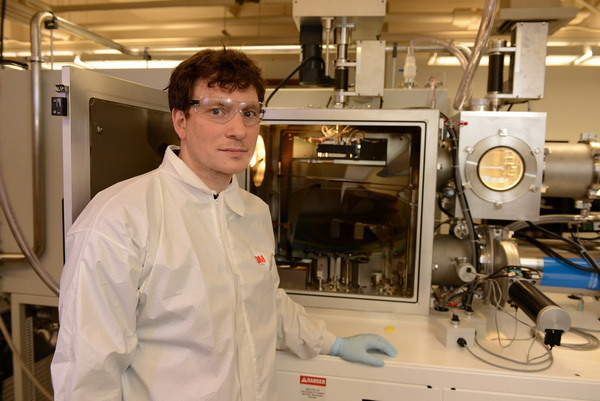A Kent State University professor in the College of Arts and Sciences has received a grant from the Binational Science Foundation to continue his development of a combined LED and organic transistor that could be used in flexible displays. Bjorn Lussem, Ph.D., an assistant professor of physics, was awarded US $180,000 to use vertical transistors to create organic displays that are more power efficient and could potentially have a higher resolution.
Organic light-emitting diode technologies, known as OLEDs, are presently used in many models of mobile phones and television sets, allowing for greater image quality and high-resolution display.
Lussem believes the most promising feature of OLEDs is not high image quality, but their flexibility. The structure of OLEDs allows them to be bended and folded, which means new types of information display technologies could be developed.
 |
|
Bjorn Loseem holding an OLED developed in his lab (shown here). (Kent State University/LEDinside) |
“Truly bendable or even foldable displays will allow for completely new designs of information displays, such as roll-up displays or wearable displays integrated in fabrics,” Lussem said. “Flexible displays will also open the way for low-cost, roll-to-roll processing for disposable medical devices and food packaging.”
James Gleeson, Ph.D., chair of the Department of Physics at Kent State, is also excited by Lussem’s work.
“Dr. Lussem’s research on not only OLEDs but other devices, such as organic transistors, represents an important new vista for all manner of electronic devices that are based upon molecules that are produced in the laboratory, rather than traditional semiconductors like silicon and germanium,” Gleeson said. “Dr. Lussem represents an integral contribution to the existing strengths within the Departments of Physics and the Department of Chemistry and Biochemistry in the area of organic electronic materials.”
 |
|
Bjorn Lussem, Ph.D., assistant professor of physics at Kent State University, studies organic light-emitting diodes (OLEDs) and organic transistors that could be used in flexible displays. (Kent State University/LEDinside) |
Lussem believes that the technology he is attempting to develop has several advantages over the existing technology.
“We will be using vertical transistors, which require less voltage and therefore less electric power, so they’re more power efficient,” he said. “Also, the vertical design allows us to pack the display pixels more densely, which could lead to a higher resolution.”
The Binational Science Foundation was established to promote scientific collaborations and relationships between the United States and Israel. Lussem’s partner on this project is Nir Tessler, a professor at Technion – Israel Institute for Technology in Haifa. The research will be conducted at both Kent State and Technion.
For more information about the Binational Science Foundation, visit www.bsf.org.il/BSFPublic.
For more information about Kent State’s Department of Physics, visit www.kent.edu/physics.





 CN
TW
EN
CN
TW
EN







